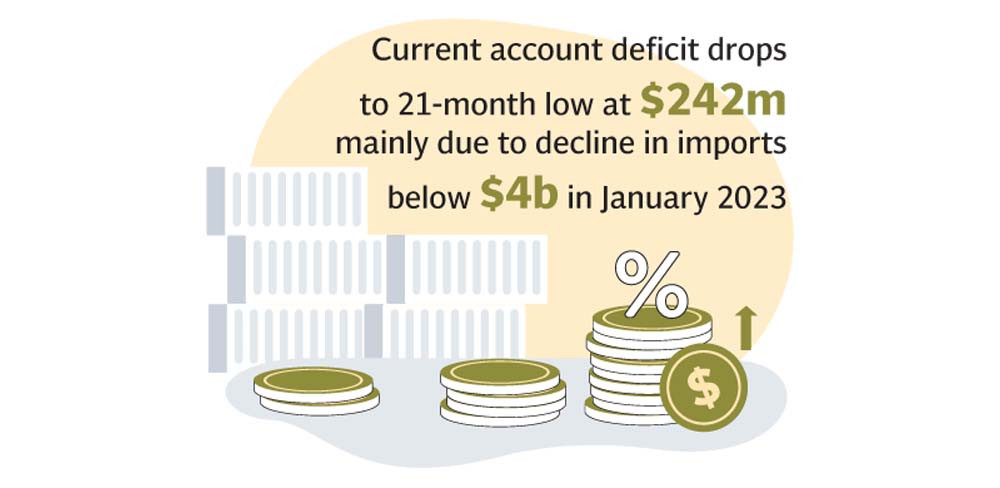
Pakistan’s administratively controlled current account deficit (CAD) – the gap between country’s higher foreign expenditure and low income – surprisingly dropped to a two-year low at $242 million mainly due to a big cut in imports slipping below $4 billion in January 2023.
Apart from imports, the turnaround in balance of trade in services into a surplus from a deficit – through administrative measures and improvement in foreign direct investment (FDI) to seven-month high at $232 million – also supported the CAD hitting a 23-month low in the month under review.
The State Bank of Pakistan (SBP) reported on Monday that the CAD declined 10 folds this January, compared to the $2.5 billion deficit in January last year. It is 17% lower than the $290 million deficit in December 2022.
Cumulatively, in the first seven-months (Jul-Jan) of FY2023, CAD decreased by 67% to $3.8 billion, compared to the $11.6 billion during the same period last year.
The controlled import of industrial raw material, however, hit economic activities badly, resulting in the closure of a large number of factories, partially or completely, and rendered millions jobless across the country.
The economic challenges, exacerbated by political instability, took the country’s foreign exchange reserves to critically low levels – leaving the central bank with only three-weeks of import cover at around $3 billion. This forced the cash-strapped government to place a partial ban on imports.
Arif Habib Limited Head of Research, Tahir Abbas said, “Imports are expected to remain thin around the current level (of $4 billion a month) amid low reserves, while export earnings and inflows of workers’ remittances are anticipated to improve in the remaining five months (Feb-Jun) of FY 2023.”
Accordingly, he predicted, “Pakistan’s current account number is expected to strike a balance or turn into a small surplus for the full current fiscal year (ending on June 30, 2023).”
“The primary reason behind the decline in CAD was a 38% year-on-year drop in total imports to $3.92 billion in January 2023,” Abbas added.
To recall, imports hit an all-time high of around $8 billion in a month in the recent past.
The reduced import number, the drop in CAD and surplus in the balance of trade have all been “achieved through administrative controls,” maintained Abbas.
Export earnings and inflow of workers’ remittances decreased by 7% to $2.20 billion and 13% to $1.89 billion respectively, in January this year compared to the same month last year.
Topline Research wrote in its report that the drop in CAD was deeper, compared to market consensus. The market was expecting the deficit to be somewhere in the range of $300-400 million for January, it was learnt.

“Export earnings and workers’ remittances are expected to improve in the remaining five months of the current fiscal year, especially given that the rupee-dollar exchange rate recorded a much-awaited drop of 16.5%, in 10 days (Jan 25 to Feb 3, 2023), to an all-time low of Rs276.58/$ in the interbank market. It settled at a new three-week high at Rs261.88/$ on Monday,” said Abbas.
He anticipated that economic growth would slow to 1%-1.25% in the FY2023 due to restricted imports, compared to the 6% growth witnessed last year (FY22).
FDI inflow surges
Foreign investors have made a seven-month high investment at $232 million in select sectors of the economy, mainly in power generation and food sectors, in January.
FDI witnessed a net outflow of $17 million in December 2022. According to the central bank, outflows more than doubled in January this year, compared to $110 million in the same month last year.
The analyst, however, believes that the improvement in FDI inflows was seen on the back of selected investment in power generation and food sectors instead widespread investment in connection with the revival of the International Monetary Fund programme.
Cumulatively, in the first seven month of FY23, the FDI inflows slowed down by a massive 44% to $685 million compared, to $1.22 billion in the same period of the last year.
He further noted that the inflows were mainly recorded in power, oil and gas exploration and financial businesses in the seven months.
Secondly, the inflows were mainly received from China under the banner of the China-Pakistan Economic Corridor.
Published in The Express Tribune, February 21st, 2023.
Like Business on Facebook, follow @TribuneBiz on Twitter to stay informed and join in the conversation.



























COMMENTS
Comments are moderated and generally will be posted if they are on-topic and not abusive.
For more information, please see our Comments FAQ